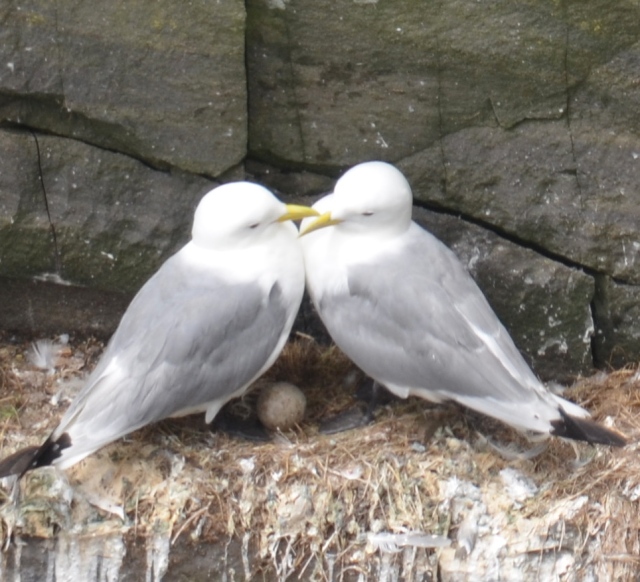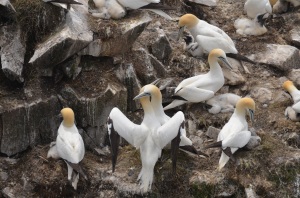We arrived at the ferry terminal for the trip to Newfoundland and were amazed by the size of the ships. The ferry was over 750 feet in length and had ten floors. The inside was set up like a cruise ship, thankfully, since we had around a 15 hour trip, leaving North Sydney around 6:30 PM and and arriving around 10:00 in the morning in Argentia, about two hours from St. John’s. Our cabin was 2 bunk beds so Janice figured out how to flip up the top so we did not crash our heads at night. The beds we very single beds and “leaned” a little but we slept well until about 6:30 am. The boat trip was an easy crossing and we arrived on schedule.
Stopping at the famous info center, we got all the local information for the St. John’s area. We were informed that the Cape Saint Mary Ecological Preserve at the south tip of the Avalon Peninsula washed on three sides by the Atlantic was considered one of the most spectacular (and accessible!) sea bird colonies in North America. We were told that for over a century, naturalists and lovers of the outdoors have been drawn to the preserve, amazed by the immensity; the whirling clamor of 70,000 seabirds and the whales that can be seen from the shore.
It was a good 90 minute drive south and John and Janice began wondering if this was a good choice. We arrived in a dense fog where you couldn’t even see the lighthouse across the street. You could certainly here the fog horn! We almost drove away thinking it was just a bad day, but decided to go into the interpretation center. The ranger told us that we first needed to change our shoes, flip flops don’t make it on the trail, and immediately head out to the end of the trail, about a mile to the bird nesting area and that the fog should have lifted out there. We went back, changed our shoes and headed out the rocky path. We would stop and head over to the side of the cliff to see what we could, nothing but fog.
We finally made it to the end and it was worth the trip. The colony of birds was unbelievable.

There were thousands of birds with babies and some with eggs waiting for them to hatch. One of the pairs would go off to find food and soar around the point to look for food and to return to their mate. We identified three types of birds.
Most of the nests were Northern Gannet. The Northern Gannet Gannet pairs may remain together over several seasons. They perform elaborate greeting rituals at the nest, stretching their bills and necks skywards and gently tapping bills together. These birds are spectacular divers, plunging into the ocean at high speed, with their bodies completely straightened out like an arrow before striking the water. If a fish is taken after diving, gannets swallow the fish underwater before surfacing. Although they are strong and agile fliers, they are clumsy in takeoffs and landings, they can have a wing span of 6 feet.

The Black-Legged Kittiwake, it is a species of gull. They also seemed to have a ritual when the mate returned.

Last was a Common Murre which is a type of AUK. Unlike penguins, modern auks can fly, they are good swimmers and divers, but their walking appears clumsy.

The pictures we were able to capture and the captions say it all. We were so concentrated on the birds that we didn’t search the ocean for whales.







